

What's Your Learning Style? Teacher as Researcher - Teaching in the 21st. 4 Steps to Responding to Tricky Emails. Webliography. Teacher Educator Technology Competencies (TETCs) - SITE. The Teacher Educator Technology Competencies (TETCs) were developed to support the redesign of teaching in teacher education programs so that ALL teacher educators are prepared to model and integrate technology in their teaching.
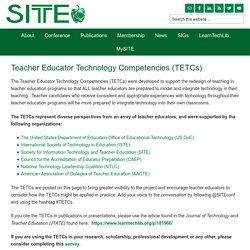
Teacher candidates who receive consistent and appropriate experiences with technology throughout their teacher education programs will be more prepared to integrate technology into their own classrooms. The TETCs represent diverse perspectives from an array of teacher educators, and were supported by the following organizations: The TETCs are posted on this page to bring greater visibility to the project and encourage teacher educators to consider how the TETCs might be applied in practice.
Add your voice to the conversation by following @SITEconf and using the hashtag #TETCs. If you cite the TETCs in publications or presentations, please use the article found in the Journal of Technology and Teacher Education (JTATE) found here: How Do Kids Learn and Remember? #motivationMonday. Interactive Notebooks - Joseph Hill's English Classes at Carlmont High School. The interactive notebook serves you, the student of literature and language, as a library, a laboratory, and a journal.
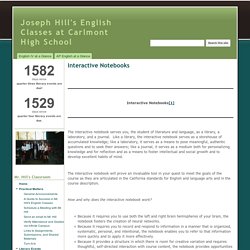
Like a library, the interactive notebook serves as a storehouse of accumulated knowledge; like a laboratory, it serves as a means to pose meaningful, authentic questions and to seek their answers; like a journal, it serves as a medium both for personalizing knowledge and for reflection and as a means to foster intellectual and social growth and to develop excellent habits of mind.
The interactive notebook will prove an invaluable tool in your quest to meet the goals of the course as they are articulated in the California standards for English and language arts and in the course description. How and why does the interactive notebook work? In short, the interactive notebook serves as a means to become an active and independent thinker and learner, to become, in fact, the best active and independent thinker and learner you can be. eWorkshop - Online Teaching Resource. Course: The Big 5 of Reading. 150 Teaching Methods. Lecture by teacher (and what else can you do!)
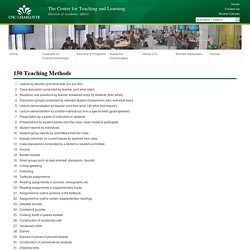
Class discussion conducted by teacher (and what else!) Recitation oral questions by teacher answered orally by students (then what!) The Augmented Reality for Education Shelf. Flipped 2. Tutorial: Cognitive And Learning Strategies. WHAT ARE COGNITIVE AND LEARNING STRATEGIES Cognitive and learning strategies are those procedures that a student uses to succeed with a task that would be difficult without special effort.
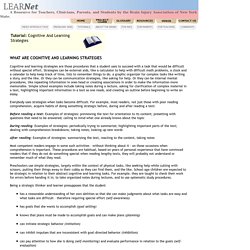
Strategies can be external aids, like a calculator to help with difficult math problems, a clock and a calendar to help keep track of time, lists to remember things to do, a graphic organizer for complex tasks like writing a story, and the like. Or they can be communication strategies, like asking for help. Or they can be internal mental procedures, like repeating information in ones head or creating associations in order to make the information more memorable. Simple school examples include taking notes during a lecture, asking for clarification of complex material in a text, highlighting important information in a text as one reads, and creating an outline before beginning to write an essay. Everybody uses strategies when tasks become difficult.
Cognitive Strategies. A cognitive strategy is a mental process or procedure for accomplishing a particular cognitive goal.
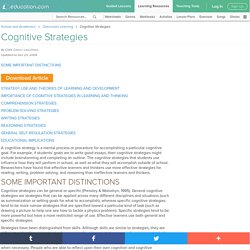
For example, if students' goals are to write good essays, their cognitive strategies might include brainstorming and completing an outline. The cognitive strategies that students use influence how they will perform in school, as well as what they will accomplish outside of school. Researchers have found that effective learners and thinkers use more effective strategies for reading, writing, problem solving, and reasoning than ineffective learners and thinkers. Instruction/Cognitive Strategies. Cognitive Strategies [Teacher Tools] [Case Studies] Cognitive strategies are useful tools in assisting students with learning problems.
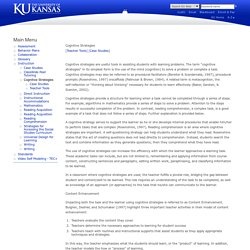
The term "cognitive strategies" in its simplest form is the use of the mind (cognition) to solve a problem or complete a task. College of Education and Human Sciences. Parent IEP Binder - Miss Click's Class. Parent Resource Binder Materials, Handouts, Links, & InformationSome of the information in the Parent Resource Binders I created for everybody is web-based or at least available online, in addition to the copies I've sent home - you'll find those links here.
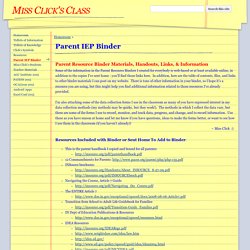
In addition, here are the table of contents, files, and links to other binder materials I can post on my website. There is tons of other information in your binder, so I hope it's a resource you are using, but this might help you find additional information related to those resources I've already provided. I'm also attaching some of the data collection forms I use in the classroom as many of you have expressed interest in my data collection methods (my methods may be quirky, but they work!). The methods in which I collect the data vary, but these are some of the forms I use to record, monitor, and track data, progress, and change, and to record information. Simplek12.titanpad. Simplek12.titanpad. Upping the Ante: Developing Critical Thinking Skills with Mobile Learning Activi.
Problem loading page. Simplek12.titanpad. Simplek12.titanpad. Simplek12.titanpad. Problem loading page. Problem loading page. Simplek12.titanpad. SK12. Thanks for joining my Simple K12 session!
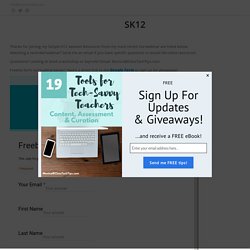
Resources from my most recent live webinar are listed below. Watching a recorded webinar? Send me an email if you have specific questions or would like extra resources! Questions? Looking to book a workshop or keynote? 15 Free Apps for Classroom Management. Student Learning, Outcomes Assessment, and Accreditation. VALUE Rubrics (Valid Assessment of Learning in Undergraduate Education): The VALUE Rubrics project is sponsored by the Association of American Colleges and Universities (AAC&U).
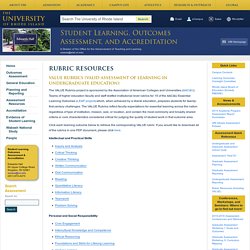
Teams of higher education faculty and staff drafted institutional level rubrics for 15 of the AAC&U Essential Learning Outcomes (LEAP project) which, when achieved by a liberal education, prepares students for twenty-first-century challenges. TeachingWorks. High-Leverage Practices The heart of the TeachingWorks strategy is to ensure that all teachers have the training necessary for responsible teaching.
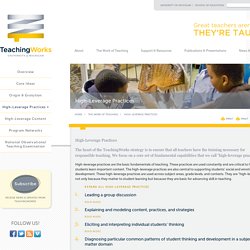
We focus on a core set of fundamental capabilities that we call "high-leverage practices. " High-leverage practices are the basic fundamentals of teaching. These practices are used constantly and are critical to helping students learn important content. The high-leverage practices are also central to supporting students’ social and emotional development.
8 Characteristics Of A Great Teacher. 8 Characteristics Of A Great Teacher by Ian Lancaster What makes a teacher strong? What differentiates the best from the rest?